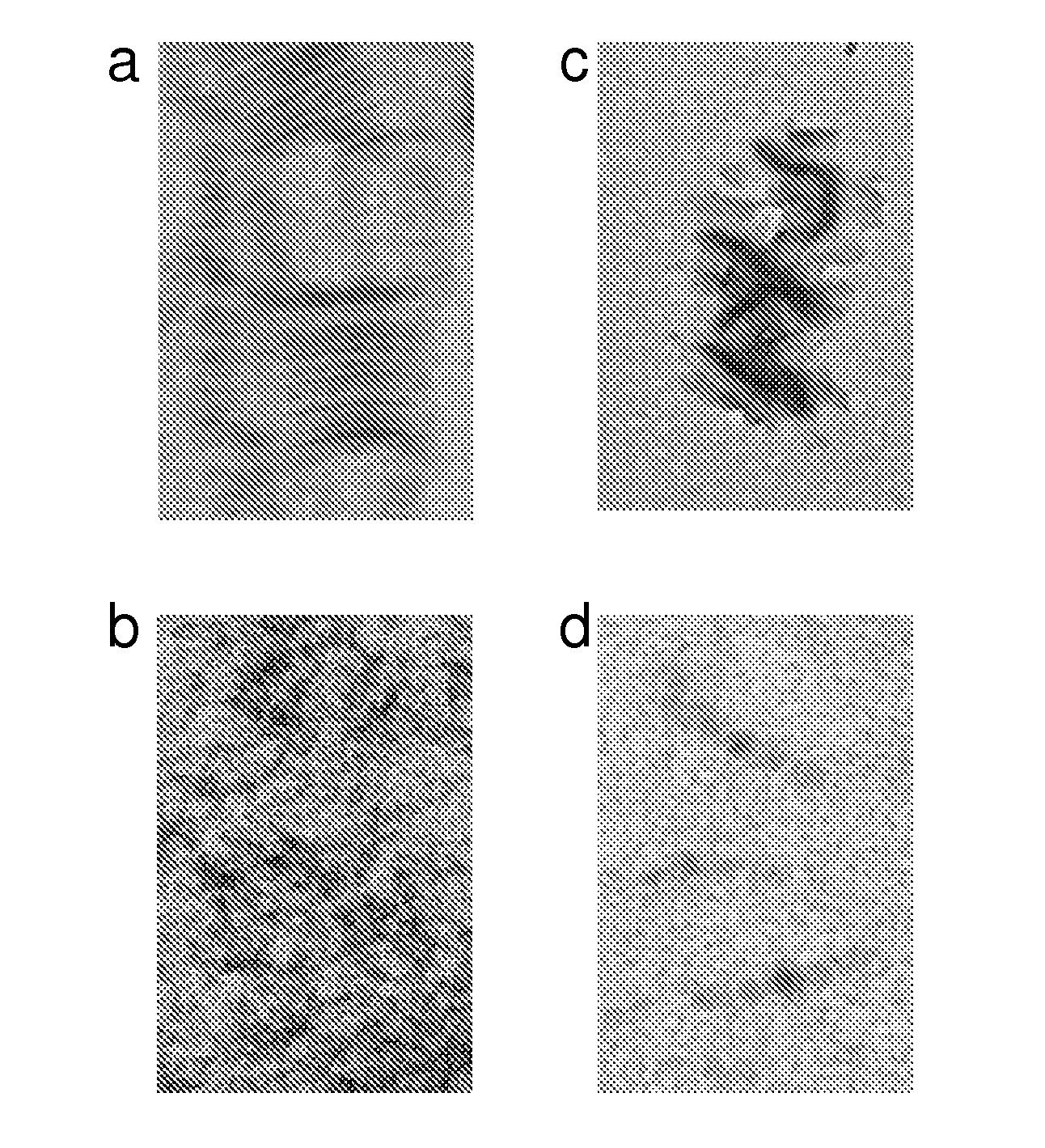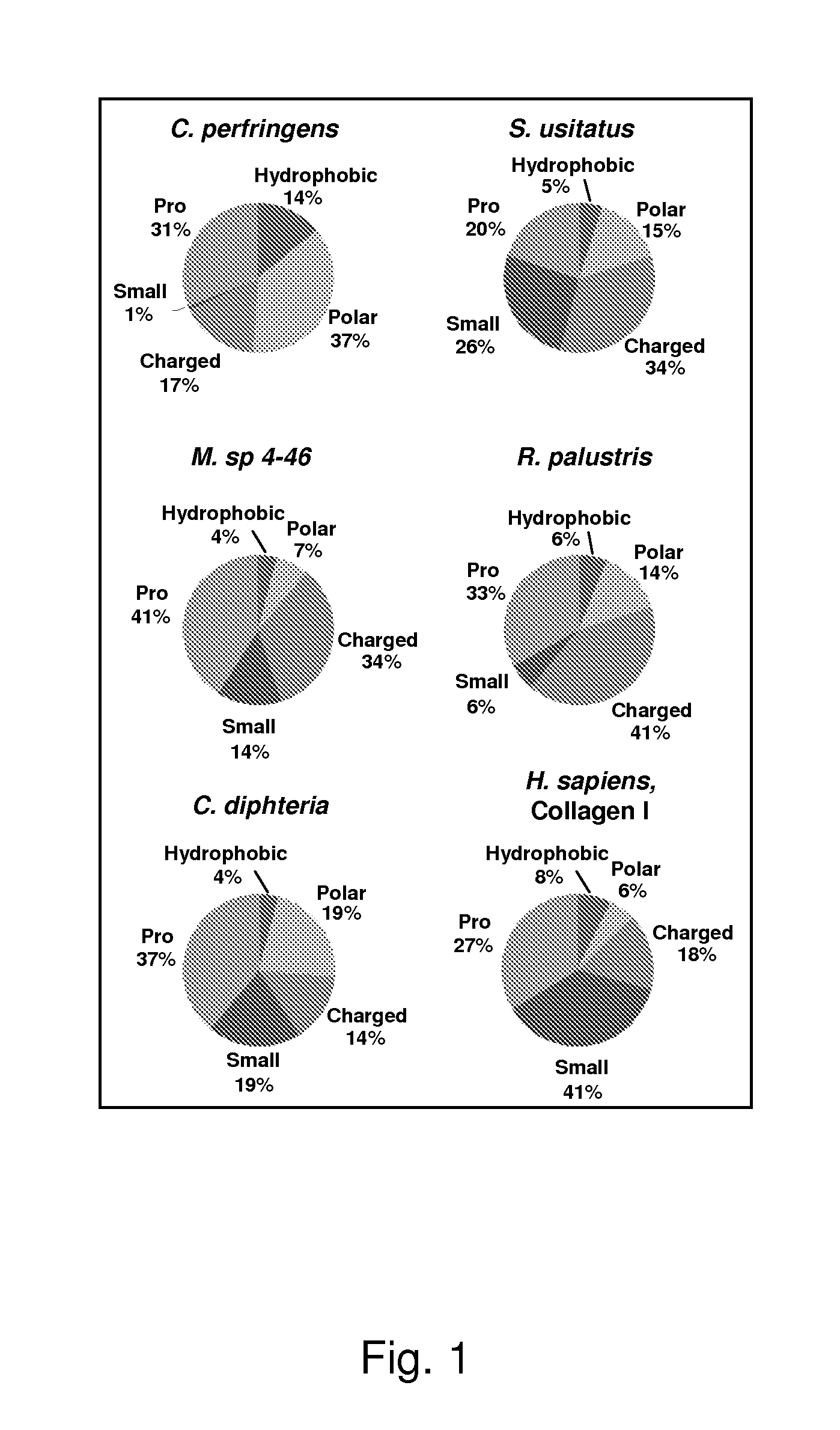Expression of triple-helical collagen-like products in e.coli
a collagen-like product and triple-helical technology, applied in the field of modules, recombinant collagen-like proteins, can solve the problems of increasing concerns, unstable collagens without hyps, and increasing the risk of contamination by infectious agents, and achieve the effect of facilitating protein folding of the triple-helical domain
- Summary
- Abstract
- Description
- Claims
- Application Information
AI Technical Summary
Benefits of technology
Problems solved by technology
Method used
Image
Examples
example 1
Selection of Collagen-Like Protein Candidates
[0074]To choose candidate proteins with collagen-like domains, a search was initiated in bacterial genomic databases of pathogenic and non-pathogenic bacteria for relatively long (Gly-Xaa-Yaa)n domains (n>35), since the stability of the collagen triple helix is known to depend upon length of the protein up to a certain size after which Tm is length independent. Candidates were further analyzed in terms of predicted thermal stability of their CL domains using the collagen stability calculator (jupiter.umdnj.edu / collagen_calculator / ), eliminating proteins predicted to have regions of low relative stability. The final protein candidates were grouped according to amino acid composition, and representative candidates with high percentage of charged residues, prolines, or predominantly polar residues were chosen for experimental investigations. It was also desirable to include proteins from non-pathogenic bacteria since none had been studied pr...
example 2
Expression of Bacterial Collagen-Like Proteins in E. coli
[0078]Genes for these candidate proteins (Table 1) were cloned from genomic DNA and expressed in E. coli BL21 strain using cold-shock expression vectors, as provided above. Initial expression plasmids were constructed using full length proteins including N or C-terminal non-collagenous domains. Such sequences are identified in FIG. 2 where the numbers indicate the length of each domain in AA; black filled boxes indicate the CL domains of corresponding proteins; the empty boxes indicate N- and C-terminal domains; vertical empty boxes indicate collagen-like sequence interruptions; and boxes with line dashed patterns indicate V domain from Scl2 of S. pyogenesis (VSp) and C-terminal V domain from R. palustris (VRp). Predicted signal peptide coding regions were not included in the constructs when they could be identified.
[0079]No inducible expression was observed for the C. diphtheria recombinants and this bacterial protein was no...
example 3
Formation of Chimeric Proteins to Promote Folding
[0081]Since insoluble proteins in inclusion bodies have been linked to misfolding, the insoluble CLCp collagen domain was fused with two potential folding domains from the collagen proteins of other bacteria. In one construct, an additional C-terminal domain of R. palustris, (C)VRp was attached to the CLCp domain, in another, it was fused with a preceding N-terminal globular (N)VSp domain of the Scl2 collagen-like protein from S. pyogenes (FIG. 2). Constructs containing CLCp domain were now expressed in the soluble fraction, suggesting these additional chimeric domains were effective in facilitation of the correct assembly of the collagen-like domain from C. perfringens. There appears to be specificity in the location of the folding domains since the V domain of R. palustris promoted folding when on the C-terminal but not the N-terminal side of CLCp. Attachment of the (N)VSp domain to the CLSu domain of S. usitatus also led to efficie...
PUM
| Property | Measurement | Unit |
|---|---|---|
| temperatures | aaaaa | aaaaa |
| temperatures | aaaaa | aaaaa |
| temperatures | aaaaa | aaaaa |
Abstract
Description
Claims
Application Information
 Login to View More
Login to View More - R&D
- Intellectual Property
- Life Sciences
- Materials
- Tech Scout
- Unparalleled Data Quality
- Higher Quality Content
- 60% Fewer Hallucinations
Browse by: Latest US Patents, China's latest patents, Technical Efficacy Thesaurus, Application Domain, Technology Topic, Popular Technical Reports.
© 2025 PatSnap. All rights reserved.Legal|Privacy policy|Modern Slavery Act Transparency Statement|Sitemap|About US| Contact US: help@patsnap.com



